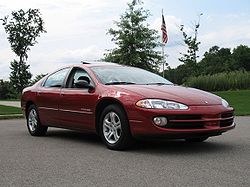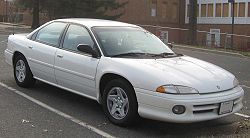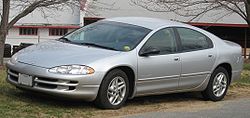- Dodge Intrepid
-
Dodge Intrepid 
Manufacturer Chrysler Corporation
DaimlerChryslerAlso called Chrysler Intrepid (Canada) Production 1993–2004 Assembly Brampton, Ontario, Canada Predecessor Chrysler Dynasty (Canada & Mexico)
Dodge Monaco (United States)
Dodge Dynasty (United States)Successor Dodge Charger
Dodge MagnumClass Full-size Body style 4-door sedan Layout FF layout Platform Chrysler LH platform The Dodge Intrepid is a large four-door, full-size, front-wheel drive sedan car model that was produced for model years 1993 to 2004. It was mechanically related to the Chrysler Concorde, Chrysler LHS, Chrysler New Yorker, Eagle Vision, and also the 300M sedans. The Intrepid, Concorde, and Vision were collectively designated the LH, Chrysler's codename for the platform which underpinned them. It was sold in Canada as the Chrysler Intrepid. It replaced the Chrysler Dynasty (Canada) and Dodge Monaco (United States) as Dodge's largest car. With Dodge's introduction to Mexico that time, it was badged as a Dodge, replacing the Dynasty when it was sold under the Chrysler brand.
Contents
Background
The Intrepid's design can be traced to 1986, when designer Kevin Verduyn completed the initial exterior design of a new aerodynamic concept sedan called Navajo. The design never passed the clay model stage.
It was also at this time that the Chrysler Corporation purchased bankrupt Italian sports car manufacturer Lamborghini. The Navajo's exterior design was reworked and became the Lamborghini Portofino, released as a concept at the 1987 Frankfurt Auto Show. The Portofino was heralded as a design triumph, setting in motion Chrysler's decision to produce a production sedan with the Portofino's revolutionary exterior design, called "cab-forward".
The cab forward design was characterized by the long, low slung windshield, and relatively short overhangs. The wheels were effectively pushed to the corners of the car, creating a much larger passenger cabin than the contemporaries of the time.
Design of the chassis began in the late 1980s, after Chrysler had bought another automaker: American Motors Corporation (AMC) in 1987. During this time, Chrysler began designing the replacement for the then-new Dodge Dynasty, which was a mid-size car. Initially it bore resemblance to the Dynasty, and this design was scrapped entirely after François Castaing, formerly AMC's Vice President of product engineering and development, became Chrysler's Vice President of vehicle engineering in 1988. The new design, under Castaing's leadership, began with the Eagle Premier.
The Premier's longitudinal engine mounting layout was inherited, as was the front suspension geometry, and parts of the braking system. The chassis itself became a flexible architecture capable of supporting front or rear-wheel drive (designated "LH" and "LX" respectively).
The chassis design was continually refined throughout the following years, as it underpinned more Chrysler prototypes: the 1989 Chrysler Millennium and 1990 Eagle Optima.
The transmission was inspired by the Premier's Audi and ZF automatics. Borrowing heavily from Chrysler's A604 (41TE) "Ultradrive" transversely-mounted automatic, it became the A606 (also known as 42LE). This "Ultradrive" transmission however was not without critics as The New York Times reported on January 25, 1991 that Consumers Union would publish in the February 1991 issue of the magazine Consumer Reports a warning for consumers to NOT purchase a vehicle with this "Ultradrive" transmission citing poor reliability and safety hazards.
By 1990, it was decided that the new technologically-advanced car would need a new technologically-advanced engine to power it. Until that time, the only engine confirmed for use was the 3.3 L pushrod V6. The 3.3 L engine's 60° block was bored out to 3.5 L, while the pushrod-actuated valves were replaced with SOHC cylinder heads with four valves per cylinder, creating an advanced 3.5 L V6. For the second generation Intrepid R/T the block was recast in aluminum as part of a comprehensive upgrade.
First generation (1993–1997)
First generation 
Production 1993–1997 Assembly Newark, Delaware, United States
Brampton, Ontario, CanadaEngine 3.3 L EGA V6
3.5 L EGE V6Transmission 4-speed 42LE automatic Wheelbase 113 in (2,870 mm) Length 1993-94: 201.7 in (5,123 mm)
1995-97: 201.8 in (5,126 mm)Width 74.4 in (1,890 mm) Height 56.3 in (1,430 mm) Curb weight 3,318 lb (1,505 kg) Related Chrysler LHS
Chrysler Concorde
Chrysler New Yorker
Eagle VisionThe first generation of LH cars debuted with fanfare at the 1992 North American International Auto Show in Detroit as three 1993 models: the Chrysler Concorde, Dodge Intrepid (badged as a Chrysler in Canada) and the Eagle Vision (badged as a Chrysler in Europe).
The Intrepid was available in two trim levels: base and the sportier, better-equipped ES, which added four-wheel disc brakes, 16" wheels with better tires, and stiffer "touring" suspension damping. All Intrepids received driver and front passenger airbags, a rarity at the time, as well as air conditioning and the four-speed automatic transmission. Anti-lock brakes were optional, as was traction control and the more powerful 3.5 L SOHC engine (214 hp peak).
The Intrepid's launch marked a new image for the Dodge brand, which began to market itself as "The New Dodge" with a sophisticated marketing campaign featuring actor Edward Herrmann, who would go on to serve as the brand's spokesperson for the rest of the decade.
Changes were few over the Intrepid's initial five-year production. A new variable-assist power steering rack replaced the original for 1994, allowing for easier parking while maintaining a firmer feel at speed. The touring suspension tuning was also made standard equipment in the base model this year. Anti-lock brakes were made standard in the ES in 1995, and in 96 a new manual shift function for the automatic transmission, called Autostick, was inherited from the Eagle Vision TSi: the first transmission of its kind available in a mainstream car. The Intrepid was often compared with the Chevrolet Lumina and Ford Taurus, and to a lesser extent, the Toyota Camry and Honda Accord.[1]
Intrepids were built at AMC's former assembly plant, originally used to manufacture the Eagle Premier, in Brampton, Ontario, Canada; and at the Chrysler plant at Newark, Delaware.
Engines
- 3.3 L pushrod V6
- 3.5 L SOHC V6
Second generation (1998–2004)
Second generation 
Production 1998–2004 Assembly Brampton Assembly in
Brampton, Ontario, CanadaEngine 2.7 L EER V6
3.2 L V6
3.5 L EGJ V6Transmission 4-speed 42LE automatic Wheelbase 113 in (2,870.2 mm) Length 203.7 in (5,174 mm) Width 2000-01: 74.6 in (1,895 mm)
1998-99 & 2002-04: 74.7 in (1,897 mm)Height 55.9 in (1,420 mm) Curb weight 3,422 lb (1,552 kg) Related Chrysler LHS
Chrysler 300M
Chrysler ConcordeThe LH cars were redesigned from the ground up for 1998. The engines were replaced by two new all-aluminum units: a DOHC 2.7 L, 200 hp (150 kW) V6 for base models, and a SOHC 3.2 L, 225 hp (168 kW) V6 for the ES. A new, top-of-the-line R/T model was added in 2000, the centerpiece of which was a redesigned version of the 3.5 L V6, now producing 242 hp (180 kW) and 234 hp (174 kW) for the ES. At the same time the 3.2 L was reduced to an option in the ES.
In 2001, the Intrepid made its debut on the NASCAR circuit, signifying the return of Chrysler to NASCAR competition after a 16-year hiatus. Drivers in the initial Dodge campaign included Bill Elliott, Jason Leffler, Ward Burton, Sterling Marlin, John Andretti, Buckshot Jones, Kyle Petty, Stacy Compton, Dave Blaney, and Casey Atwood. Marlin was the first to win in a Dodge, giving the marque its first victory since 1977, with the late Neil Bonnett driving.
In 2002, the R/T received an extra 2 hp (1.5 kW) from PCM programming changes which allowed it to have 244 hp (182 kW) on 89-octane fuel. In the same year, DaimlerChrysler began cost cutting measures that led to the deletion of various features from the Intrepid. Most notably were the deletion of the illuminated headlight switch, illuminated traction control switch, illuminated lock and window switches, door courtesy lights (replaced with red reflectors), illuminated ashtray receptacle, trunk lid liner, armrest power outlet, door emblems, driver's seat map pocket, and the blacked-out front fascia paint scheme.
The R/T was discontinued in 2003 but a new SXT model kept the 3.5 L High Output motor, increased to a 250 hp (186 kW) power rating. The SXT moniker was eventually used across the Dodge product line as a trim level. The Intrepid SXT was basically a base model Intrepid SE with the 3.5 H.O. engine taken from the R/T, with some "sportier" features such as a sunroof and spoiler. It was a value trim model actually classified as an ES (SXT), but had less features than the ES did with a more powerful motor.
Popularity of the Intrepid waned over its 12-year lifespan.[citation needed] Although the cab-forward design was still revolutionary in its own respect, and even though the car's design was still far more modern, attractive, and roomy than many of its rivals, the Intrepid was quietly retired in August 2004 to make way for Chrysler's new rear wheel drive LX vehicles.
In addition, the second generation body styles were used for commercial and government purposes. These vehicles were used to make police interceptors, fire chief cars, and taxis similar to the earlier Chevy Caprice or Ford Crown Victoria. These packages had distinctive styling differences (such as half-moon hub caps) and additional wiring to support strobes and flashers in the trunk compartment and in the front by the grill. These packages and some non-police (non-commercial) packages featured plastic front-end intake vents that routed air onto the rotors for additional cooling and stopping power.
DaimlerChrysler discontinued the Intrepid after 2004 to make room for the 2005 Dodge Magnum station wagon and 2006 Dodge Charger sedan.
 2003 Intrepid police car with the Royal Newfoundland Constabulary.
2003 Intrepid police car with the Royal Newfoundland Constabulary.
Engines
- 1998-2004 - 2.7 L V6
- 1998-2001 - 3.2 L V6
- 2000-2004 - 3.5 L V6
- 2000-2004 - 3.5 L HO V6
ESX concepts
Main article: Dodge Intrepid ESXIn the late 1990s, Chrysler used the Intrepid as a research platform for a hybrid electric vehicle in a diesel-electric configuration. Three variations were built, the Intrepid ESX, ESX II, and ESX III. The first vehicle was built in a series hybrid configuration, while the next two were considered mild hybrids. These were attempted in the time frame of 1997 to 1998.
The ESX design team set a high goal of making the vehicle capable of sipping gasoline at the rate of 80 miles per US gallon (2.9 L/100 km; 96 mpg-imp), but the eventual vehicle only achieved an estimated 55 miles per US gallon (4.3 L/100 km; 66 mpg-imp). The figure was impressive for such a vehicle. However, the car used a number of exotic materials, which made the cost excessive if it were ever to go into full-scale production. It was estimated that the car would cost $80,000, or roughly $60,000 more than a regular Intrepid. Part of this price increase was caused by the use of lead-acid batteries.
The ESX II team set a somewhat more modest goal of 70 miles per US gallon (3.4 L/100 km; 84 mpg-imp). The vehicle was made much lighter than normal by using an aluminum frame and carbon fiber composite material. This version only cost around $37,000, or about $15,000 more than a standard Intrepid. This version used nickel metal hydride batteries.
The third vehicle, the ESX III, had a target mileage of 72 miles per US gallon (3.3 L/100 km; 86 mpg-imp). It used less expensive materials, such as injection-molded thermoplastic instead of carbon fiber. The estimated cost was only about $7,500 more than a standard vehicle, which would give a total somewhere around $30,000. The ESX III used lithium ion batteries.
Trim levels
- Base – 1993–1999
- ES – 1993–2004
- R/T – 2000–2002
- SE – 1999–2004
- Sport – 1996–1997
- SXT – 2002–2004
Awards
The Intrepid and Concorde were on Car and Driver magazine's Ten Best list for 1993 and 1994. The second-generation Intrepid again made the list for 1998 and 1999. Both generations won Consumer Guide's "Best Buy" award.
Oil Sludge
Some second-generation 2.7 L V6 engines have suffered from failures due to oil sludge contamination.[2][3] In February 2009, five separate class action lawsuits related to the alleged oil sludge defect were consolidated to the District of New Jersey.[4] During the Chrysler bankruptcy proceedings, there was concern among consumer advocate groups that Chrysler's proposed "free and clear" sale of assets to "New Chrysler" would allow the automaker to avoid liability for the oil sludge defect.[5]
References
- ^ Popular Mehanics-April 1993-The Intrepid Challenge
- ^ "Engine Failure and the Chrysler 2.7L V6 engine". OilSludge.com. http://www.oilsludge.com. Retrieved 2010-09-29.
- ^ "The Center For Auto Safety - Oil Sludge". Autosafety.org. http://www.autosafety.org/getcat.php?cid=28. Retrieved 2010-09-29.
- ^ MDL No. 2006 Transfer Order, In RE: Chrysler LLC 2.7 Liter V-6 Engine Oil Sludge Products Liability Litigation, U.S. Judicial Panel on Multidistrict Litigation, February 10, 2009.
- ^ Statement of Clarence M. Ditlow On Auto Industry Bankruptcies Before the House Judiciary Committee, May 21, 2009
External links
- DodgeIntrepid.net - The Original Dodge Intrepid Forum.
- Chrysler Hybrid-Electric Cars of the 1990s: Dodge Intrepid ESX Accessed May 29, 2004.
« previous — Dodge road car timeline, United States market, 1980s–present Type 1980s 1990s 2000s 2010s 0 1 2 3 4 5 6 7 8 9 0 1 2 3 4 5 6 7 8 9 0 1 2 3 4 5 6 7 8 9 0 1 2 Subcompact Omni Colt Colt Colt Colt Omni 024 Charger Compact Colt 400 Shadow Neon Neon Caliber Aspen Aries Mid-size Lancer Mirada 600 Spirit Avenger Diplomat Dynasty Stratus Stratus Full-size St. Regis Monaco Intrepid Intrepid Magnum Charger Charger Sport compact Daytona Avenger SRT-4 Sports Challenger Conquest Stealth Challenger Viper Viper Viper Viper Dodge Cars Vans / SUVs Historic 024 · 330 · 400 · 600 · 880 · Aries · Aspen · Avenger · Brisa · Caliber · Challenger · Charger (B-body) · Charger (L-body) · Charger Daytona · Colt · Conquest · Coronet · Custom 880 · Dart · Daytona · Demon · Diplomat · Dynasty · Intrepid · La Femme · Lancer · Matador · Mirada · Monaco · Neon · Omni · Phoenix · Polara · SE · Shadow · Sierra · Spirit · SRT-4 · St. Regis · Stealth · Stratus · Super BeeHistoric Vans / SUVs Corporate Fratzog · John Francis Dodge · Horace Elgin Dodge · Ram Truck Division · Category:Dodge vehicles · Chrysler LLCCategories:- Dodge vehicles
- Front wheel drive vehicles
- Full-size vehicles
- Sedans
- 1990s automobiles
- 2000s automobiles
- Vehicles introduced in 1993
Wikimedia Foundation. 2010.
